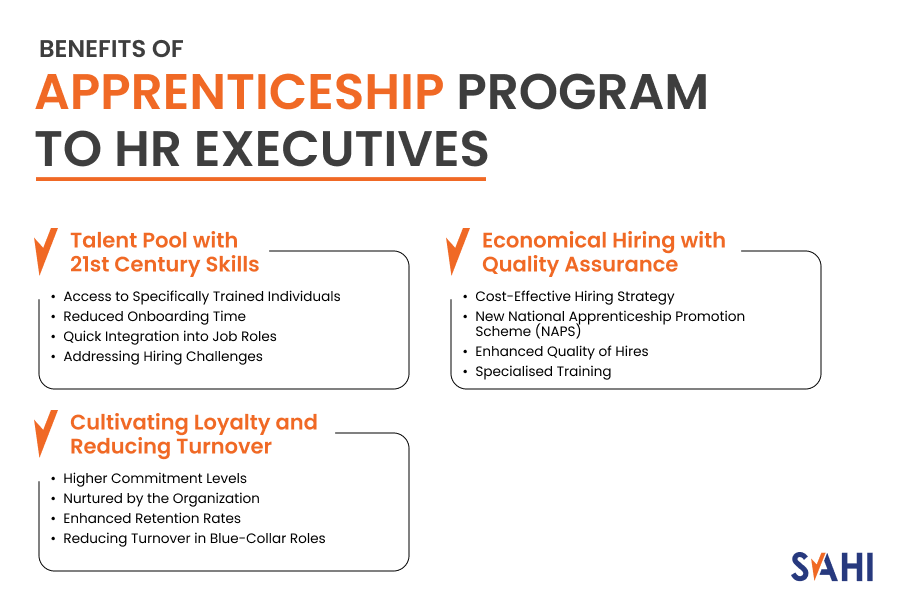In the ever-evolving landscape of the corporate world, HR executives and managers continually face the daunting task of meeting stringent hiring targets.
For roles, especially blue-collar ones, the challenges amplify as they strive to find quality hires within a constrained time frame. It’s not just about quantity but quality, and balancing both is where the real challenge lies. In this scenario, the question arises: Is there a silver bullet solution?
The answer, intriguingly, lies in the age-old system of apprenticeships, connecting businesses to this solution. It helps businesses scale their operations by staffing open job roles with apprentices, which reduces costs and makes it convenient to adjust to market demands.
Apprenticeship programmes, especially when framed under the National Apprenticeship Promotion Scheme (NAPS), present a streamlined, efficient, and impactful avenue to tackle these hiring challenges head-on.
This piece sheds light on the significant benefits offered by such programmes and how they stand as a game-changer in workforce staffing.
What are the Challenges in Hiring?
Why is Meeting Hiring Targets an Uphill Task?
With the expanding industries and a continually growing economy, the demand for blue-collar workers has seen an unprecedented rise. Yet, finding the right candidates for these roles, who bring both skill and dedication, is a significant challenge that HR strategies often grapple with.
What is The Quality versus Quantity Dilemma?
Filling seats is one task, but ensuring those seats are occupied by proficient, trained individuals is another. HR executives frequently find themselves at crossroads, trying to achieve a balance between the two.
Why Traditional Methods Fall Short?
Time Constraints and Limited Resources
Relying solely on conventional hiring practices often results in prolonged hiring cycles, leaving HR professionals racing against the clock.
The High Cost of Bad Hires
Beyond the immediate monetary implications, a bad hire can lead to decreased productivity, lower team morale, and an increase in turnover rates.
Apprenticeship Programmes: What is the Strategic Solution?
Unveiling the Power of Apprenticeships
Apprenticeship programmes bridge the gap between theoretical learning and practical work. They cultivate young minds, grooming today’s trainees to become tomorrow’s skilled specialists.
This system not only provides companies with a dynamic, future-ready workforce but also offers the trainees a competitive edge in their careers. The key is for businesses to access the best talent who can fulfil organisational goals.
Tapping into a Vast Pool of Potential
With apprenticeships, companies gain access to a wide array of candidates, all undergoing rigorous training tailored to the specific needs of the business. This system ensures that the recruits are not just any candidates, but the right candidates.
What is the Power of Apprenticeship Programmes? Steering the Future of Hiring
In the intricate tapestry of human resource strategies, apprenticeship programmes have emerged as a shining thread. They are knitting together the world of academia and the dynamic demands of the industry.
For HR executives, particularly those facing the perennial challenge of hiring quality blue-collar workforce, apprenticeship programmes are nothing short of a revelation.
This exploration dives deep into the structure, myriad benefits, and transformative potential of these programmes in reshaping hiring paradigms.
Apprenticeship Programmes Demystified
The Conceptual Framework
At their core, apprenticeship programmes are a meticulous blend of classroom instruction and on-the-ground training. This dual approach ensures that apprentices not only acquire skill development insights but also hands-on experience, making them industry-ready.
The Legacy and Modern Evolution
From the age-old guild systems to today’s intricate programmes tailored to modern-day industry needs, apprenticeships have evolved, ensuring they remain relevant and impactful in today’s workforce management landscape.
Phased Learning and On-Job Training
A typical apprenticeship programme might span from 1 to 4 years. This journey comprises theoretical learning, hands-on workshops, and real-time job exposure, ensuring a holistic grooming of the apprentice.
Accreditation and Recognition
Rigorous evaluations benchmark the progress of apprentices. Successful completion garners them industry-recognized certifications, bolstering their career prospects and ensuring they meet hiring standards.

Why Should HR Executives Take Notice?
Talent Pool with 21st Century Skills
Tapping into the reservoir of apprentices means having access to individuals who have been specifically trained for job roles. This dramatically reduces onboarding time and ensures quick integration into job roles, addressing many hiring challenges.
Economical Hiring with Quality Assurance
Apprenticeships, especially under schemes like the new National Apprenticeship Promotion Scheme (NAPS), can be a cost-effective hiring strategy. Simultaneously, the quality of hires is enhanced, given their specialised training.
Cultivating Loyalty and Reducing Turnover
Apprentices, having been nurtured by the organisation, often exhibit higher commitment levels. This results in enhanced retention rates, thus reducing the often-criticised turnover rates in blue-collar roles.
How are Apprenticeship Programs A Game-Changer in Meeting Hiring Goals?
Addressing Volume and Quality
For HR executives, the dual challenge has always been volume and quality. Apprenticeship programmes, by their very design, address both. They ensure a steady stream of candidates, all groomed to meet specific industry standards.
Reinventing the HR Strategies Wheel
Incorporating apprenticeship programmes can revolutionise HR strategies. Instead of reactive hiring, HR can transition to a more proactive, planned, and strategic hiring model, making the process more efficient and targeted.
How to Build Strong Employer Branding with Apprenticeship Programs?
Showcasing Commitment to Skill Development
Companies that adopt apprenticeship programmes send out a strong message about their commitment to skill development and employee growth. This bolsters their reputation in the industry, attracting even more talent.
Community Engagement and Social Responsibility
By investing in apprenticeships, companies also contribute to community development, upskilling the youth, and playing a pivotal role in nation-building.
The strength of apprenticeship programmes in today’s hiring landscape is undeniable. They offer a structured, quality-assured, and efficient pathway to not just meet, but exceed hiring targets.
For HR executives seeking innovative solutions to age-old hiring challenges, the power of apprenticeship programmes, especially in the context of apprenticeship in India, beckons to be harnessed.
Thus, businesses will have at their disposal apprentices who can be part of a future-ready workforce.
What is the Role of NAPS in Catalyzing Apprenticeships? Building India’s Skilled Workforce
In a rapidly developing nation like India, skill development is paramount. Addressing the skills gap and nurturing a workforce ready for tomorrow’s challenges is vital. This is where the National Apprenticeship Promotion Scheme (NAPS) steps in, playing a crucial role in promoting apprenticeships.
As we unravel the essence of NAPS, its objectives, benefits, and its transformative impact on organisations’ hiring practices will become clear.
Understanding the NAPS Paradigm
The government introduced a central sector scheme called the National Apprenticeship Promotion Scheme (NAPS). It was, and is, completely funded by the central government so that all states have access to the best talent pool in the country.
During the past 7 years, it engaged over 13.38 lakh apprentices. The number of apprentices has also jumped significantly from 2.90 lakh to 5.8 lakh from 2020-21 to 2021-22.
This shows that employment generation has increased while the skill gap has been bridged to an extent. Apprentices are now equipped with 21st century skills, which will be further carried forward by NAPS.
The Dual Approach
NAPS isn’t just about numbers; it’s about quality too. The scheme emphasises both increasing the quantity of apprentices and enhancing the quality of apprenticeship programmes, ensuring they align with industry needs and global standards.
The National Apprenticeship Promotion Scheme (NAPS) Advantages
NAPS was introduced by the central government as a way to hire apprentices for efficient staffing solutions who possess 21st century skills that meet modern industry standards. This leads to higher employability and increases the earning potential for apprentices.
Moreover, the recruitment cost for employers goes down and it becomes easier to retain candidates.
What is the Cost-Sharing Scheme?
Businesses will cover 75% of the stipend, while the government will cover the remaining 25% with a maximum contribution of Rs 1,500 for every apprentice.
What is the Direct Benefits Transfer (DBT)?
NAPS introduces a streamlined stipend payment process via Direct Benefits Transfer. This ensures apprentices receive their stipends on time, reducing administrative overheads for businesses.
25% of the stipend will be directly transferred to the bank accounts of apprentices.
What is Zero-Compliance Assurance?
With apprenticeship programmes, companies can rest assured that all legal, HR formalities, and statutory compliances are handled with ease. This makes the entire process hassle-free.
How does it Address the Skill Development Imperative?
Beyond just hiring, NAPS places a strong emphasis on skill development, ensuring apprentices are not only job-ready but are also equipped with skills that set them apart in the industry.
In a world where HR executives are continually searching for innovative solutions to hiring challenges, apprenticeship programmes, especially under NAPS, emerge as a strategic solution. With benefits ranging from cost-effective hiring to skill development and a boost in retention rates, these programmes promise to reshape the landscape of blue-collar workforce management.
For companies looking to stay ahead in the hiring game, it’s time to recognize the potential of apprenticeships in India and harness their power.
What are the Core Objectives of NAPS?
Fostering Skill Development
NAPS aims to facilitate skill development, turning India’s vast young population into an asset. Through structured apprenticeships, individuals acquire not just theoretical knowledge but also practical experience.
Strengthening Industry-Academia Linkages
The scheme endeavours to bridge the gap between academic institutions and industries. By doing so, it ensures that the training apprentices receive is in sync with industry demands.
Enhancing Employability
By promoting apprenticeships, NAPS directly boosts the employability of individuals. Apprentices, with their hands-on experience and industry-relevant training, become prime candidates for various roles, aiding in their career progression.
How to Transform Organizations’ Hiring Dynamics?
What are the Benefits of Apprenticeships Under NAPS for Organizations?
Businesses Have An Edge
Organisations no longer need to start from scratch. With NAPS, they get access to candidates who’ve undergone rigorous training tailored to industry standards, easing many hiring challenges.
Bolstering Brand Image
Associating with a government-backed initiative like NAPS enhances an organisation’s brand image, showcasing their commitment to skill development and nation-building.
How to Streamline Hiring of Apprentices? Simplifying Compliance and Formalities
One of the significant challenges in hiring apprentices is navigating the intricate maze of legal and compliance requirements. NAPS offers guidelines and support, simplifying this process for organisations.
Promoting Industry-Specific Training
Organisations under NAPS ensure apprentices are trained as per specific industry needs. This results in better job-role alignment and reduced training time post-hiring.
The National Apprenticeship Promotion Scheme (NAPS) has proven to be a cornerstone in promoting apprenticeship in India. Its emphasis on marrying skill development with industry needs makes it a valuable ally for organisations.
For companies aiming to stay ahead in the hiring game, understanding and leveraging the benefits of NAPS is no longer just an option—it’s a necessity.
What are the Practical Steps and Best Practices for Implementing Apprenticeship Programmes?
Apprenticeship programmes have emerged as the linchpin in building a skilled and robust workforce. However, initiating and managing these programmes requires strategic planning, meticulous execution, and adherence to best practices.
This guide will pave the way for organisations, elucidating the steps to kickstart apprenticeship programmes, leverage benefits under the new National Apprenticeship Promotion Scheme (NAPS), and integrate apprentices seamlessly into the workforce.
Embarking on the Apprenticeship Journey
Is Defining Clear Objectives Important?
Before diving into apprenticeship programmes, ascertain the specific needs of the organisation. Whether it’s for skill development in niche areas or bolstering the blue-collar workforce, clear objectives set the right direction.
Why Think about Workforce Solutions?
Effective workforce solutions include choosing platforms with a vast reach and expertise. This makes it easier to source and hire apprentices under NAPS. Moreover, there is no need for tedious paperwork as the onboarding process is digitised.
SAHI is one such provider of Apprenticeship programmes with a great expertise in this field. It provides access to a wide talent pool, having a reach into 23 states and 5 union territories, while offering tailored staffing solutions for various job roles.
Businesses can source the best candidates and streamline the hiring process right up to onboarding and beyond. In other words, it is a one-stop solution for hiring on a full-time basis, or temporary and contract staffing solutions as per market demands.
How to Leverage NAPS?
The new National Apprenticeship Promotion Scheme is a goldmine for organisations, helping them find candidates specifically interested in apprenticeships. It simplifies the hiring challenges linked with sourcing suitable candidates.
How to Craft a Structured Training Curriculum?
Align with Industry Standards
The training modules should resonate with current industry demands, ensuring apprentices gain relevant knowledge and skills.
Integrate Feedback Mechanisms
Regular feedback sessions help in recalibrating the training methods, ensuring continuous improvement and alignment with organisational objectives.
Optimising and Integrating Apprenticeships
How to Foster a Conducive Learning Environment?
Invest in Mentoring
Assign mentors to apprentices. Their guidance can help apprentices navigate the initial phases, making the transition smoother and more effective.
Ensure Hands-On Exposure
Balance theoretical lessons with practical sessions. This on-ground experience is crucial for apprentices to understand real-world challenges and solutions.
What Happens with Regular Evaluations and Feedback?
Set Benchmarks
Establish clear performance benchmarks for apprentices, ensuring they are on the right track and meeting the expected standards.
Constructive Critique
Instead of just pointing out shortcomings, offer solutions. Constructive feedback ensures apprentices not only understand their areas of improvement but also the ways to address them.
How to Ensure Seamless Integration into the Workforce?
Recognize and Reward
Upon successful completion of the apprenticeship programme, recognize their achievements. Consider offering them full-time roles, which can be a significant morale booster.
Continuous Learning Opportunities
The end of an apprenticeship programme shouldn’t mean the end of learning. Offer opportunities for further skill enhancement and training, ensuring their growth trajectory remains upward.
What are Some of the Best Practices to Ensure Success?
Know about NAPS
Stay updated with the latest guidelines and benefits offered under NAPS. This can include cost sharing and DBTs, which can make the apprenticeship programmes more cost-effective.
Open Channels of Communication
Ensure that apprentices feel heard. Open communication channels encourage them to voice concerns, share feedback, and seek guidance, fostering a positive learning environment.
Why is Continuous Improvement Important?
The world of HR strategies and industry demands is ever-evolving. Regularly update the apprenticeship curriculum, ensuring it remains relevant and impactful.
Implementing apprenticeship programmes is not just about training newcomers; it’s about shaping the future of the organisation. By following the outlined steps and adhering to best practices, especially leveraging benefits under NAPS, organisations can ensure they mould apprentices who are not just job-ready but are valuable assets.
How to Harness the Future of Hiring Through Apprenticeships?
In today’s dynamic hiring landscape, apprenticeship programmes stand tall as a beacon of innovation and efficiency. These programmes are not mere training initiatives. They represent a seismic shift in how organisations approach hiring, especially for the blue-collar workforce.
By bridging the gap between academic learning and real-world application, apprenticeships promise a workforce that’s both knowledgeable and hands-on ready.
Central to this transformative journey with the National Apprenticeship Promotion Scheme (NAPS). Beyond its financial aspect, NAPS serves as a testament to the nation’s commitment to skill development and employment enhancement.
It’s a clarion call, heralding the importance of structured, industry-aligned staffing that resonates with the actual demands of the workplace. For organisations, NAPS isn’t just a scheme; it’s a strategic partner in reimagining hiring paradigms.
What Does this Mean For HR Executives?
To the HR executives steering the ship of recruitment and workforce management: the future beckons. Apprenticeship programmes, especially under the aegis of NAPS, offer an unparalleled opportunity.
They promise not just numbers, but quality, dedication, and a workforce aligned with the vision of the organisation.
Dive into the world of apprenticeships and make hiring easier for organisations by streamlining everything from hiring to retention and separation. Access the best blue-collar talent and apprentices in India based on market demands without affecting business operations.
Embrace the change, harness its potential, and set your organisation on a trajectory of sustainable success by accessing the best pool of apprentices. The time is ripe; seize the moment.
SAHI makes this process easy and helps businesses scale their workforce on demand. It has over 14 years of industry experience and ensures businesses can tap into the best blue-collar talent in the country.
Use contract staffing, temporary staffing, or more permanent solutions as per your need. Start recruiting today!


